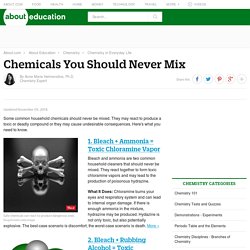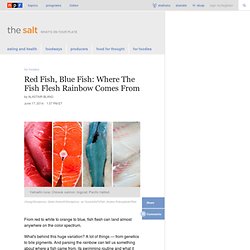

Distilled Versus Deionized Water. Chemicals You Should Never Mix. 7.

AHA/Glycolic Acid + Retinol = Waste of $$$ Skincare products that actually work to lessen the appearance of fine lines and wrinkles include alpha-hydroxy acids (AHAs), glycolic acid, and retinol. Layering these products won't make you wrinkle-free. In fact, the acids reduce the effectiveness of retinol. What It Does: Skincare products work best at a certain acidity level or pH range.
Labs, Demos, Activities. Temperature: From the Hottest to the Coldest Things In the Cosmos. Atoms and subatomic particles vibrate and move around when they’re hot.

The hotter they are, the faster they move. The colder they are, the slower they move. In fact, at absolute zero all movements from the atoms completely stops. You can’t get colder than that. It’s like trying to go South from the South Pole, or North from the North Pole. Below is an infographic that details the hottest things (or moments) in the known universe. Hottest and coldest things in the known universe. 50 (nearly) Unbelievable Facts About Earth. Did you know that there are more than 22,000 man-made objects currently in orbit around our planet?

Admittedly, most of them are rather small (far too small for us to see or even notice); however, it is interesting to think about all of that stuff—all of the satellites, technological systems, and bits of space junk that accumulated over the years—silently drifting across the sky as we look up at the stars. In the end, Earth is a rather interesting place. This infographic, created by Giraffe Childcare and Early Learning, provides an overview of some of the more fascinating facts about our planet. Everything You Ever Wanted to Know About Planet Earth (and then some) What Does Our Light Signature Reveal About Earth?
Interplanetary Contamination: Could Earth Infect the Universe with Life? Why Does Earth Have so Little Water? Jolene Creighton Jolene is a freelance science writer; she also teaches at the University of Southern Mississippi where she focuses on Ecocriticism and Environmentalism. Pretending To Be A Medical Patient Pays Off For This Teen. Third-year medical student Allie Tetreault, left, talks with Gabrielle Nuki, 16, at Maine Medical Center in Portland, Maine.

Gabrielle helps med students practice patient care. Patti Wight/MPBN hide caption itoggle caption Patti Wight/MPBN Third-year medical student Allie Tetreault, left, talks with Gabrielle Nuki, 16, at Maine Medical Center in Portland, Maine. Gabrielle helps med students practice patient care. How Does the Brain Learn Best? Smart Studying Strategies. Do Not Fear This Giant Robot Swarm.
Food, Drug, Cosmetics. Medicine and Biotechnology. Red Fish, Blue Fish: Where The Fish Flesh Rainbow Comes From. Hide captionYellowfin tuna; Chinook salmon; lingcod; Pacific halibut.

Chang/iStockphoto; Debbi Smirnoff/iStockphoto; via TeachAGirlToFish; Andrea Pokrzywinski/Flickr Yellowfin tuna; Chinook salmon; lingcod; Pacific halibut. From red to white to orange to blue, fish flesh can land almost anywhere on the color spectrum. What's behind this huge variation? A lot of things — from genetics to bile pigments. Hide captionA yellowfin tuna caught in the Gulf of Mexico; a yellowfin tuna steak. NOAA/Flickr;Chang/iStockphoto A yellowfin tuna caught in the Gulf of Mexico; a yellowfin tuna steak. Red yellowfin tuna: A classic of the sashimi counter, the yellowfin tuna is also the Michael Phelps of the fish world. Bruce Collette, a zoologist with the National Marine Fisheries Service, tells The Salt that the endurance-swimmer tuna need lots of oxygen to feed their muscles.
Putting Science to Work. They Did It To Pluto, But Not To Pink! Please Not Pink! : Krulwich Wonders... Pluto isn't a planet anymore. It's been demoted. Now it's pink's turn. I'm talking about the color pink. Plants and Animals. What Happened On Easter Island — A New (Even Scarier) Scenario : Krulwich Wonders...
We all know the story, or think we do.

Let me tell it the old way, then the new way. See which worries you most. Robert Krulwich/NPR First version: Easter Island is a small 63-square-mile patch of land — more than a thousand miles from the next inhabited spot in the Pacific Ocean. In A.D. 1200 (or thereabouts), a small group of Polynesians — it might have been a single family — made their way there, settled in and began to farm. These settlers were farmers, practicing slash-and-burn agriculture, so they burned down woods, opened spaces, and began to multiply. As Jared Diamond tells it in his best-selling book, Collapse, Easter Island is the "clearest example of a society that destroyed itself by overexploiting its own resources. " When Captain James Cook visited there in 1774, his crew counted roughly 700 islanders (from an earlier population of thousands), living marginal lives, their canoes reduced to patched fragments of driftwood.
Germs and Microbes. The New Science Behind Picky Eaters.